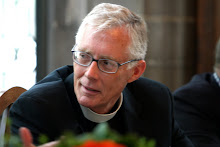The Answers to All Life’s Big Questions
Well, not really—but I knew that nobody would read an essay titled “Thoughts on the Annual Meeting”. But now that I have your attention, I hope you’ll read on.
By canon law, parishes in the Episcopal Church have annual meetings, usually in the month of January. The purpose of these meetings is threefold: to hear reports on work and finances for the preceding year; to elect members to the church’s governing board, the Vestry; and to discuss important issues in the parish’s common life.
Some years, parish annual meetings can be quite contentious. Most years, they are quite routine. While I do not anticipate any major controversies this year, there are some important issues to come before us. Let’s take them by category.
When you come to the meeting, you’ll receive a hefty packet of Annual Meeting reports. Virtually every ministry area in the parish—from worship to pastoral care to education to outreach—is represented in these reports. The size of this packet might be daunting, but I hope it won’t deter its avid reading. Most of Christ Church Cranbrook’s ministry is carried out through the work of its people. The staff, while essential to the optimal functioning of the congregation, serves primarily to support, train, recruit, and supervise the baptismal ministry of the church’s members. So I ask that you read the work reports not as staff report cards but as reflections on what God is doing in and through the people who make up the congregation.
I’ve asked that the chairs of the four working groups designated by the Vestry and me as of high strategic importance (Stewardship, Outreach, Children and Youth, Communications) report on their ongoing work in 2011. By highlighting those areas, we’re NOT saying that their work is more important than that done by others. But we are saying that these areas are so vital to the vitality and future of the parish that they need our shared, constant attention.
Next comes the Vestry election. I am deeply grateful that eight dedicated and able parishioners have offered themselves to be considered for five slots. I hope that when you vote for those five people you take into account the deepest needs of Christ Church Cranbrook as it moves ahead. Most vitally, it’s good to remember that all Vestry members are “at large” members: each one is elected by the congregation as a whole. While the nominating committee tries to plan for diversity of age, interest, experience, and for gender balance in the slate, the priority for a governing board of a congregation as large as this one is less about the representation of constituencies than it is about the presence of vital competences. The Vestry is called to think, act, decide, and plan for the whole system. As you consider the nominees, think about what skills you believe should be present in the group that, above all others here, speaks and acts for you.
Finally, we’re considering some changes to the parish By-Laws. The proposed amendments attempt to align our standing committee structure both with our missional priorities and with the functional realities of the way things work. We’ve added Children and Youth and Outreach as standing committees of the Vestry. When surveying the committee structure, I noticed that there was no structural Vestry connection to church school and youth ministry and that Service and Outreach was only an ad hoc group. The proposed amendments give these priority areas a clear connection to the Vestry’s engagement. In two other areas we’ve proposed structural refinements that bring clarity to the current system. The Stewardship Committee is the only standing committee charged with developing parish financial resources. The new language gives the Stewardship Committee authority to create subcommittees that will carry on its work in three areas: annual giving, capital giving, and planned giving. And the language making the Columbarium Committee a subcommittee of the Building and Grounds committee merely confirms current practice.
The Vestry and I think of these By-Law changes as non-controversial. Their intent is to conform our structure to our practice. Please read and reflect on the changes (they’re posted on the website) and bring your responses and ideas to the meeting.
So much for the answers to all life’s big questions. In a sense, though, that’s what we get by living together in the community that gathers in response to the life and ministry of Jesus. The answers to all life’s big questions come finally not in ideas but in relationships. Living out our baptismal covenant with each other, in the context of the Eucharist, is the real meaning of what life is all about. I’m grateful for everyone here and their companionship in this community.


No comments:
Post a Comment